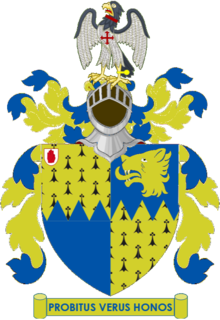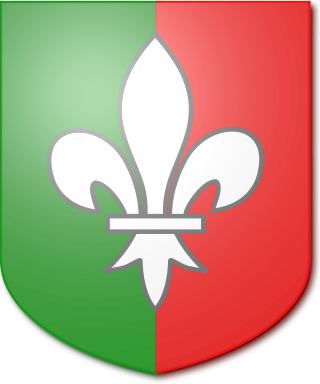Arms
 |
|
The Lacon Baronetcy, of Great Yarmouth in the County of Norfolk, is a title in the Baronetage of the United Kingdom. [1] It was created on 11 December 1818 for Edmund Lacon. The second Baronet was High Sheriff of Norfolk. The third Baronet sat as Conservative Member of Parliament for Great Yarmouth and Norfolk North. The family seat has been Ormesby House in Ormesby St Michael.
The heir apparent to the baronetcy is Luke Edmund Lacon (born 2001)(6ft5), only son of the 9th Baronet. [9]
 |
|

Viscount Hardinge, of Lahore and of Kings Newton in the County of Derby, is a title in the Peerage of the United Kingdom. It was created in 1846 for the soldier and Tory politician Sir Henry Hardinge. His son, the second Viscount, represented Downpatrick in Parliament. His great-great-grandson, the sixth Viscount, succeeded a distant relative as eighth Baronet, of Belle Isle in the County of Fermanagh, in 1986. This title had been created in the Baronetage of the United Kingdom 1801 for Richard Hardinge. He was the third son of Nicolas Hardinge, younger brother of Reverend Henry Hardinge and uncle of the latter's third son Henry Hardinge, 1st Viscount Hardinge. The baronetcy was created with special remainder to the heirs male of Richard Hardinge's father.

The Hobhouse Baronetcy, of Chantry House in the parish of Bradford-on-Avon in the County of Wiltshire and of Westbury College in the County of Gloucester, is a title in the Baronetage of the United Kingdom. It was created on 22 December 1812 for Benjamin Hobhouse, a wealthy brewer and member of parliament for Bletchingley, Grampound and Hendon. His eldest son, the second Baronet, was a prominent writer and Liberal politician and notably served as Chief Secretary for Ireland and as President of the Board of Control. In 1851 he was raised to the peerage as Baron Broughton, of Broughton-de-Gyffard in the County of Wiltshire. However, he had no sons and on his death the barony became extinct, while he was succeeded in the baronetcy by his nephew, the third Baronet. The latter's son, the fourth Baronet, was also a noted Liberal politician and held office as Chancellor of the Duchy of Lancaster and as Postmaster General.

The Antrobus Baronetcy, of Antrobus in the County Palatine of Chester, is a title in the Baronetage of the United Kingdom.

There have been two baronetcies created for persons with the surname Backhouse, once in the Baronetage of England and once in the Baronetage of the United Kingdom. As of 2023 one creation is extant.

The Bagge Baronetcy, of Stradsett Hall in the County of Norfolk, is a title in the Baronetage of the United Kingdom. It was created on 13 April 1867 for William Bagge, Conservative Member of Parliament for West Norfolk. The sixth Baronet was Chairman of the West Norfolk District Council between 1976 and 1977.

The Cradock-Hartopp Baronetcy, of Freathby in the County of Leicester and of Four Oaks Hall in the County of Warwick, was a title in the Baronetage of Great Britain. It was created on 12 May 1796 for Edmund Cradock-Hartopp, Member of Parliament for Leicestershire. Born Edmund Bunney, he was the husband of Anne Hurlock, granddaughter and heiress of Sir John Hartopp, 4th Baronet, of Freathby. On his marriage in 1777 he assumed the surname of Cradock-Hartopp in lieu of his patronymic according to the wills of his uncle Joseph Cradock and his wife's grandfather. His eldest surviving son Edmund, the second Baronet, died childless and was succeeded by his younger brother, William, the third Baronet. The title then descended from father to son until the death of his grandson, Charles, the fifth Baronet, in 1929.
The Broadhead, later Brinckman Baronetcy, of Burton or Monk Bretton in the County of York, is a title in the Baronetage of the United Kingdom. It was created on 30 September 1831 for Theodore Broadhead, Member of Parliament for Yarmouth. In 1842 he resumed by Royal Licence the old family surname of Brinckman in lieu of his patronymic. Brinckman was the son of Theodore Broadhead, who also represented Yarmouth in the House of Commons, son of Theodore Broadhead, High Sheriff of Surrey in 1786, who assumed the surname of Broadhead in lieu of Brinckman by Act of Parliament. The latter's grandfather Theodore, Baron Brinckman, had emigrated to Britain from Hanover. The first Baronet was succeeded by his eldest son, the second Baronet. He sat as Liberal Member of Parliament for Canterbury. His grandson, the fourth Baronet died childless in 1954 and was succeeded by his younger brother, the fifth Baronet. The latter was a colonel in the Grenadier Guards, Aide-de-Camp to the Governor of Victoria and to the Governor-General of Canada and Chief of Staff to the British Military Mission in Moscow during the Second World War.

The Edge Baronetcy, of Ribble Lodge in Lytham St Annes in the County Palatine of Lancaster, is a title in the Baronetage of the United Kingdom. It was created on 9 June 1937, for the Liberal politician Sir William Edge. He represented Bolton and Bosworth in the House of Commons.

The Fowke Baronetcy, of Lowesby in the County of Leicester, is a title in the Baronetage of the United Kingdom. It was created on 7 February 1814 for Frederick Gustavus Fowke of Lowesby Hall, Lowesby, near Leicester. He was the son of Lieutenant-General Sir Thomas Fowke, Groom of the Bedchamber to the Duke of Cumberland. His grandfather was Lieutenant-General Thomas Fowke, Governor of Gibraltar. The family surname is pronounced "Foke".

The Stracey baronetcy, of Rackheath in the county of Norfolk, is a title in the baronetage of the United Kingdom. It was created on 15 December 1818 for Edward Stracey. He was the eldest surviving son of Sir John Stracey, chief judge of the Sheriff's Court and a recorder of London.

The Levinge Baronetcy, of High Park in the County of Westmeath, is a title in the Baronetage of Ireland. It was created on 26 October 1704 for Richard Levinge, Speaker of the Irish House of Commons and Lord Chief Justice of the Irish Court of Common Pleas. The seventh Baronet sat as Liberal Member of Parliament for Westmeath from 1857 to 1865.

The ffolkes Baronetcy, of Hillington in the County of Norfolk, is a title in the Baronetage of Great Britain. It was created on 26 May 1774 for Martin ffolkes, FRS later High Sheriff of Norfolk and Member of Parliament for King's Lynn. The second Baronet represented Norfolk and Norfolk West in the House of Commons while the third Baronet represented King's Lynn. The fifth Baronet was Honorary Chaplain to Queen Victoria, Chaplain-in-Ordinary to Edward VII and George V and Chaplain to Edward VIII and George VI.

The Elton Baronetcy, of Bristol, is a title in the Baronetage of Great Britain. It was created on 31 October 1717 for Abraham Elton, Mayor of and Member of Parliament for Bristol from 1722 to 1727. The second Baronet was also Mayor of Bristol and represented Taunton and Bristol (1727–1742) in the House of Commons. The seventh Baronet sat as Liberal Member of Parliament for Bath. The eighth Baronet was High Sheriff of Somerset in 1895. The tenth Baronet was a pioneer of the British documentary film industry.
Sir Edmund Henry Knowles Lacon, 3rd Baronet was an English businessman and liberal Conservative politician who sat in the House of Commons in two periods between 1852 and 1885.
Sir Edmund Knowles Lacon, 2nd Baronet of Ormesby House, Ormesby St Margaret, Norfolk, was an English Mayor of Great Yarmouth, High Sheriff of Norfolk and Member of Parliament.

The Shaw baronetcy, of Bushy Park in the County of Dublin, was created in the Baronetage of the United Kingdom on 17 August 1821 for the Tory politician Robert Shaw. The 3rd Baronet was also a politician.
The Falkiner baronetcy, of Anne Mount (Glounthaune), in the County of Cork, was created in the Baronetage of Ireland on 24 August 1778 for Sir Riggs Falkiner, 1st Baronet. He represented Clonakilty in the Irish House of Commons.

The Kaye, later Lister-Kaye baronetcy, of Grange in the County of York, was created in the Baronetage of the United Kingdom on 28 December 1812 for John Lister Kaye. He was the illegitimate son and heir of the 5th Baronet of the 1642 creation.

The Simeon baronetcy, of Grazeley in the County of Berkshire, was created in the Baronetage of the United Kingdom on 22 May 1815 for John Simeon, Member of Parliament for Reading and Senior Master of the Court of Chancery. The evangelical cleric Charles Simeon was his brother.

The Hare baronetcy, of Stow Hall in the County of Norfolk, was created in the Baronetage of the United Kingdom on 14 December 1818 for Thomas Hare, a soldier of the American Revolutionary War; he was the grandson of Thomas Leigh, husband of Mary, second daughter of the 2nd Baronet of the 1641 creation, and sister and co-heiress of the 5th Baronet of that creation. Born Thomas Leigh, he assumed by Act of Parliament the surname of Hare in lieu of his patronymic in 1791.